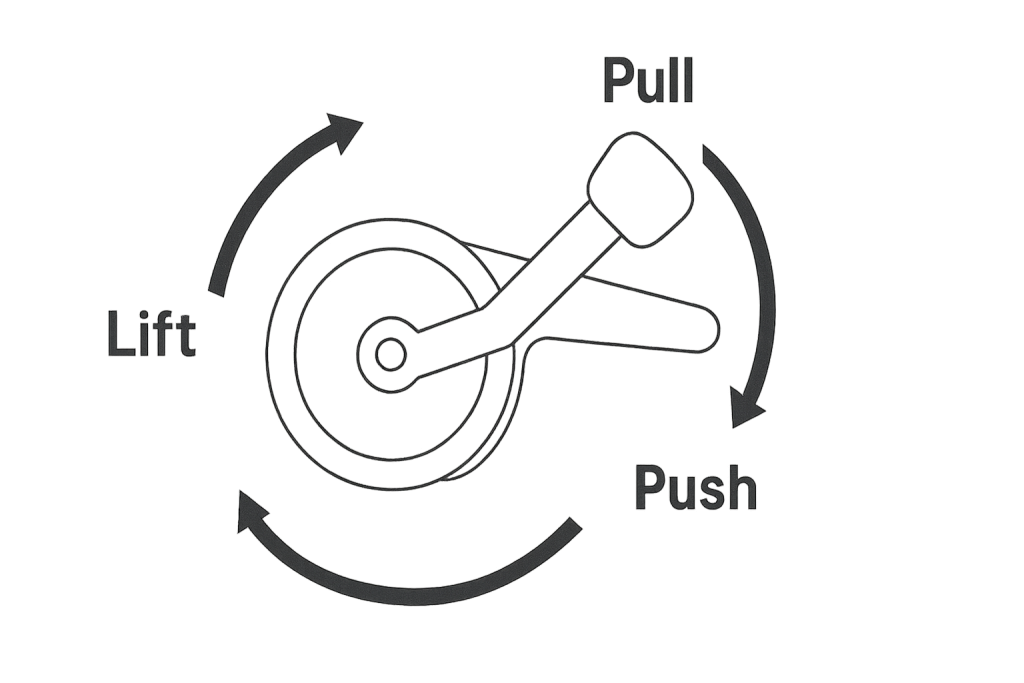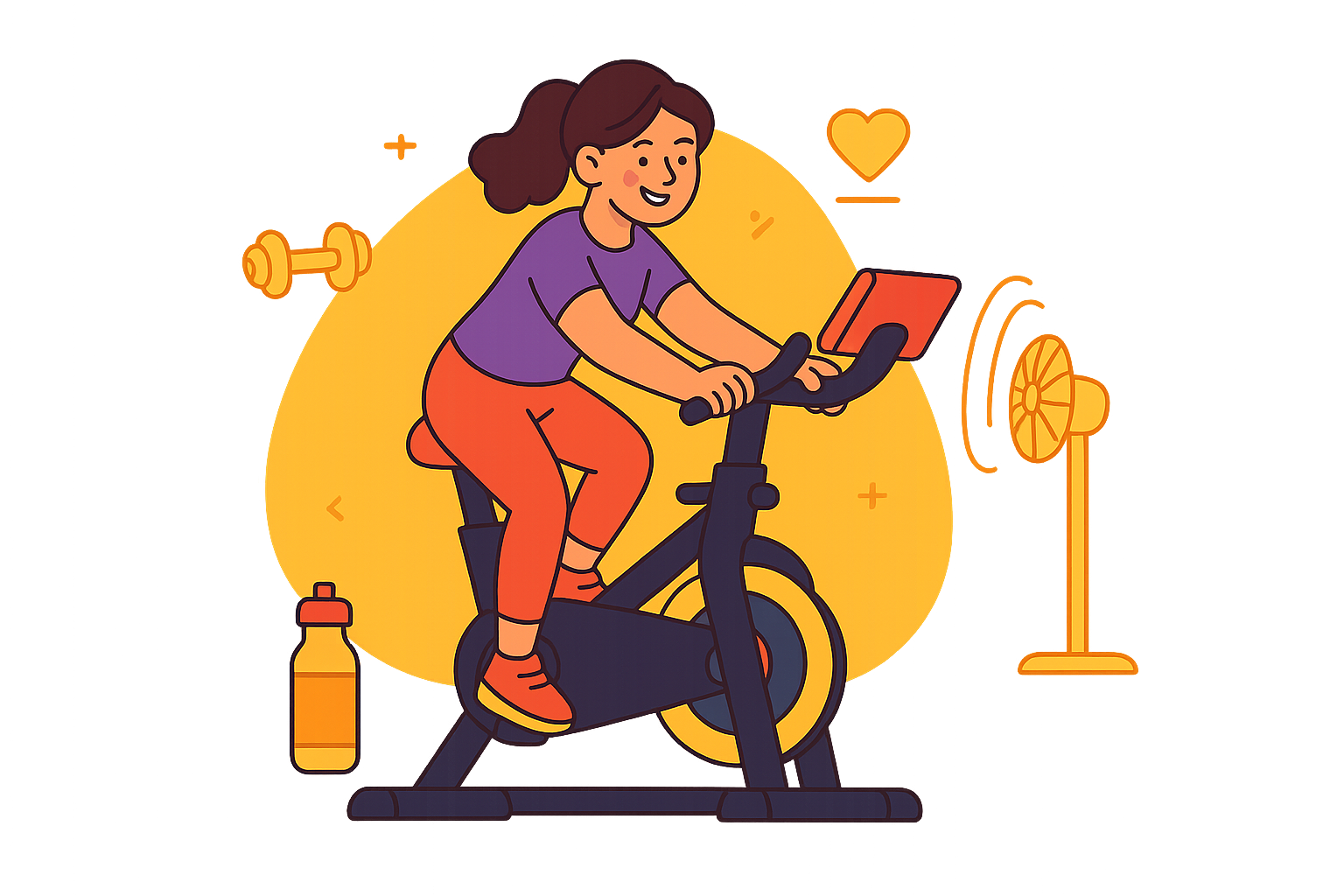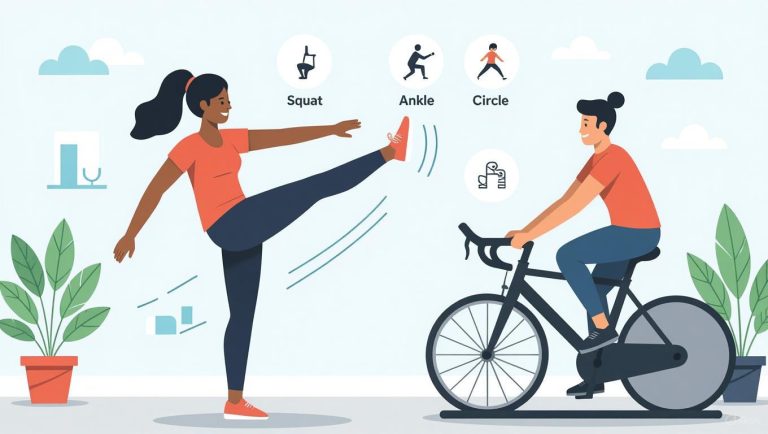How to Start Indoor Cycling Workouts as a Beginner
Introduction: Why Indoor Cycling is a Game-Changer for Beginners
At the start of my fitness journey, it wasn’t very difficult for me to learn how to start Indoor cycling, and I quickly realized that it was something that I could stick to in order to maintain my fitness level. Indoor cycling is a great way to improve your fitness level without the challenges of weather, traffic, or time limitations that often get in the way of outdoor cycling.
The good news for anyone considering this fitness journey is that starting indoor cycling workouts is far easier than most people think. Unlike riding on the open road, where you need to master balance and safety, indoor training lets you focus purely on technique, endurance, and strength training. This controlled environment makes it an excellent way for beginners to develop proper form and build a strong fitness foundation.
Whether you have a busy schedule that makes outdoor rides a challenge or you’re looking for a convenient alternative to the gym, an indoor cycling bike offers unmatched flexibility. You can squeeze in a 20-minute indoor workout before work or enjoy an hour-long virtual ride through virtual worlds all from the comfort of your own home.
This comprehensive guide will walk you through everything from selecting the right bike to structuring your first workout routine, ensuring you have the knowledge and confidence to begin your indoor cycling journey successfully.

Section 1: Choosing Your Setup – The First Thing to Consider
The first thing to think about for your indoor cycling success is selecting the appropriate equipment. The perfect bike depends entirely on your specific goals, available space, and budget.
The Right Equipment: Spin Bikes, Exercise Bikes, and Trainers
Understanding the differences between these three primary options will help you make an informed decision that aligns with your fitness goals and living situation.
Spin Bikes vs. Exercise Bikes vs. Trainers
| Feature | Exercise Bike | Spin Bike | Trainer |
|---|---|---|---|
| Riding Position | Upright, comfortable | Aggressive, forward-leaning | Matches your road bike |
| Flywheel | Lighter | Heavier for realistic feel | N/A (uses bike’s) |
| Resistance | Adjustable, built-in programs | Friction/magnetic, precise | Varies by model (basic or smart) |
| Best For | Beginners, comfort-focused cardio | Simulating outdoor rides, intensity | Existing bike owners, economical |
A stationary bike typically features a more upright riding position, with a comfortable seat and easy-to-reach handlebars. These bikes often include built-in programs and an adjustable resistance level that makes them appealing to beginners seeking simplicity.
Spin bikes, by contrast, position riders in a more aggressive, forward-leaning posture that mimics road bike riding. They have heavier flywheels, which create smoother pedal stroke and a more realistic cycling sensation. The resistance on spin bikes typically uses friction pads or magnetic systems, allowing for precise control during intense workouts.
An exercise bike is a good option for people who prioritize comfort during longer, steady-state cardio sessions. However, spin bikes are a good way to simulate the feel of riding outdoors for those who want to eventually transition to road cycling.
Indoor Trainers: Your Road Bike’s Best Friend
An indoor trainer transforms your existing road bike into a stationary exercise machine. This makes it an economical choice for cyclists who already own quality outdoor equipment. This setup is also a good reason for serious cyclists to maintain their bike’s specific fit and feel while training indoors.
Basic rear wheel-mounted trainer models offer simple resistance mechanisms and typically cost less than standalone bikes. However, a smart turbo trainer has revolutionized the world of indoor cycling by providing precise power output measurements, automatic resistance adjustments, and connectivity to popular indoor cycling apps. This technology gap between a basic trainer and a smart trainer is substantial. A smart bike can simulate hill climbs and respond to virtual terrain changes, which improves training effectiveness.
Direct Drive vs. Wheel-on Trainers
| Aspect | Direct Drive Trainer | Wheel-on Trainer |
|---|---|---|
| Setup | Replaces rear wheel | Clamps onto rear wheel |
| Benefits | No tire wear, quieter, accurate power | Affordable, easy setup |
| Drawbacks | More expensive | Tire wear (needs special tire) |
Direct drive trainers replace your bike’s rear wheel entirely, connecting directly to your bike’s drivetrain. This design eliminates rear tyre wear, reduces noise, and provides more accurate power measurements compared to wheel-on trainer alternatives.
Wheel-on trainers clamp onto your rear wheel and apply resistance through contact with your tire. While more affordable and easier to set up, they require a trainer-specific tire to prevent excessive wear on your regular cycling tires.
Section 2: Getting Ready for Your First Indoor Ride
Proper preparation helps a lot with your first indoor cycling experience. The small details can make the difference between an enjoyable workout and a frustrating struggle.
Essential Accessories and Gear
Comfortable cycling clothes don’t need to be expensive or specialized. Moisture-wicking materials work better than cotton, which tends to hold sweat and become uncomfortable. Padded cycling shorts can also add comfort, especially the first time you sit on a bike saddle.
The most important thing to remember is hydration. Position your water bottle within easy reach of your handlebars. Indoor cycling creates more heat than outdoor riding because there is less airflow, so regular hydration is very important for safety and performance. A heart rate monitor provides valuable feedback about your exercise intensity and helps prevent overexertion during early workouts. Many affordable monitors connect easily with popular apps and trainers. For more advanced tracking, a power meter measures your actual power output in watts, providing objective data about your performance improvements over time.
Setting Up Your Space
Proper ventilation makes indoor cycling significantly more comfortable and sustainable. A good fan that blows air across your body simulates the natural cooling effect of outdoor cycling. Consider how much space your trainer setup requires, including room for your bike to move during hard efforts and space for you to get off safely. A dedicated training space, even if it’s small, helps you stay consistent with your cycling routine.
Section 3: Your First Workouts: Building a Strong Foundation
Building a sustainable indoor cycling practice requires patience and progressive development. Many beginners make the mistake of attempting overly ambitious workouts that lead to burnout or injury.
The Anatomy of a Good Workout
Every good workout follows a structured format that prepares your body for work and helps it recover.
A proper warm-up prepares your body for increased activity while reducing injury risk. Begin each indoor cycling session with 10-15 minutes of easy pedaling, gradually increasing intensity. During the warm-up, focus on establishing a smooth, circular pedal stroke.
Focusing on Good Form

Maintaining good form throughout your workout prevents injury and maximizes efficiency. Proper pedal stroke technique involves pushing down with the ball of your foot, pulling back at the bottom of the stroke, and lifting up on the opposite side. Your upper body should remain relatively stable, with slight engagement through your core muscles. Practice different positions on the bike during your workouts, such as seated and standing, to develop balanced muscle strength.
The First Workout: An Easy Endurance Ride
Your first indoor ride should focus on getting familiar with your equipment and building baseline fitness rather than being a high-intensity effort. Plan for 20-30 minutes of steady, conversational-pace riding that feels challenging but not overwhelming. Focus on maintaining your own pace rather than comparing yourself to others. This conservative approach might feel too easy initially, but it builds the aerobic foundation necessary for more challenging workouts later.
Section 4: Taking Your Indoor Cycling Journey to the Next Level
Once you have established comfort and consistency, technology can transform your workouts from simple exercise into engaging, goal-oriented training sessions.
Exploring Training Programs and Apps
The world of indoor cycling has expanded with connected fitness platforms that bring professional instruction and community engagement to your home setup.
Apps like Zwift have created immersive virtual worlds where you can explore digital landscapes, join a group ride, and compete in structured events. These platforms combine gaming elements with serious training tools, making workouts more engaging. Most apps offer free trials that allow you to explore features before committing to subscriptions.
Erg Mode and Specific Training Zones
A smart trainer operating in erg mode automatically adjusts resistance to maintain specific power targets. This allows you to focus on pedaling efficiency rather than constant resistance adjustments. This technology ensures you stay within specific training zones no matter how your cadence varies.
Training zones based on your functional threshold power help you target specific goals like building an aerobic base, improving your threshold, or increasing anaerobic power. Understanding these zones changes random exercise into purposeful training directed toward specific needs.
Whether your focus is weight loss, strength workouts, or performance improvement, zone-based training provides clear structure and measurable progress.
A Sample Beginner’s Training Plan
A sustainable weekly indoor cycling training plan for beginners might include:
| Day | Workout |
|---|---|
| Monday | Rest or easy 20-30 minute recovery ride |
| Tuesday | 45-minute endurance ride in Zone 2 |
| Wednesday | 30-minute session with 3 x 5-minute sweet spot intervals |
| Thursday | Rest or light cross-training |
| Friday | 30-minute interval training with 6 x 2-minute efforts |
| Saturday | Longer endurance ride (60-90 minutes) or Zwift ride |
| Sunday | Active recovery or complete rest |
Listen to your energy levels and adjust this schedule based on how your body responds. The key principle is consistency over intensity.
Section 5: Troubleshooting and Staying Consistent
Even a well-planned program can run into obstacles that test your commitment.
Dealing with Knee Pain

Knee pain during or after cycling often indicates bike fit issues or improper technique. Check that your seat height allows for a slight knee bend at the bottom of each pedal stroke. A fully extended leg suggests the seat is too high, while an excessive bend indicates it’s too low. If pain persists despite proper bike fit, consult a physical therapist who understands cycling biomechanics.
The Time of Year and Staying Motivated
Indoor workouts are an excellent option for the time of year when outdoor riding is difficult. However, the lack of scenery can make motivation a challenge. Combat this by varying your training programs, exploring different virtual courses, or scheduling regular video calls with friends during online classes.
Making it a Habit
Consistency is the best way to build lasting fitness habits. It is a good idea to schedule your workouts at the same time each day to establish a routine. Treat your sessions like important appointments that you would not cancel. Start with a realistic commitment you can maintain consistently rather than an ambitious plan that becomes overwhelming. Three 30-minute sessions per week, done consistently, produce better long-term results than sporadic efforts.
Conclusion: Your Indoor Cycling Journey Starts Now
Beginning your indoor cycling journey requires choosing appropriate equipment, developing proper technique, and building a sustainable routine that aligns with your lifestyle. The key steps are selecting the right bike or trainer, establishing consistent habits, and gradually progressing as your fitness level improves.
The best workout is the one you will actually do consistently. Begin with modest goals, celebrate small victories, and trust that your fitness level will improve steadily with regular effort. Your future self will thank you for starting today, regardless of how simple that beginning might seem. Your next level of fitness awaits.




![The Best HIIT Over 50 For Women [No Equipment Needed]](https://fiit4lyfe.com/wp-content/uploads/2023/09/HIIT-Over-50-Compressed-768x432.png)

